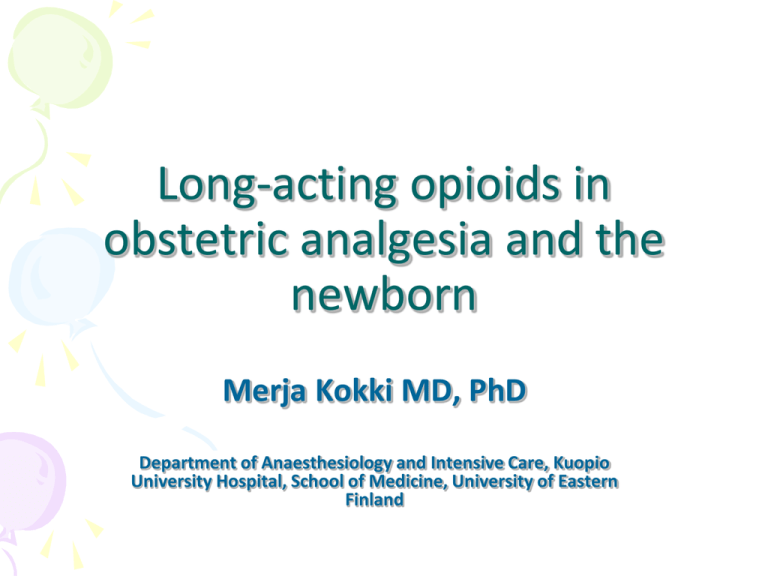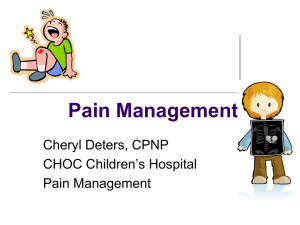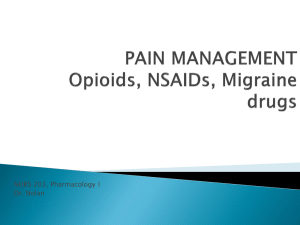Long-acting opioids in obstetric analgesia and the newborn
advertisement

Long-acting opioids in obstetric analgesia and the newborn Merja Kokki MD, PhD Department of Anaesthesiology and Intensive Care, Kuopio University Hospital, School of Medicine, University of Eastern Finland Contents • • • • • • • • Placenta and placental drug permeability Tramadol Hydromorphone Oxycodone Morphine/diamorphine Opioid dependent mother Pharmacogenetics Closure Take home message • Opioids are moderately efficacious in labour pain • Optimal doses and dosing time not known • Pethidine use will/should decrease • Oxycodone is a useful opioid in labour pain • The drug effect on newborn must be followed Placenta • In humans: haemomonochorial placenta – single layer of trophoblast tissue separates the mother's blood from the blood capillaries of the foetus Placental drug permeability • Passive diffusion – concentration gradient – lipid solubility – flow dependent transfer • Diffusion of ions as non-ionized base – most of the opioids Physicochemical properties of opioids Molecular weight pKa base Protein group binding (%) Principal binding protein Morphine 285 7.9 30 Albumin Pethidine 247 8.5 30-65 AAG Methadone 309 9.3 60-90 AAG Oxycodone 315 16.2 45 Albumin Buprenorphine 467 8.4 96 -, globulins Drugs and the effects to the newborn • Direct effects – Placental transfer • Indirect effects – Maternal physiology and biochemistry Equilibrium distribution across placenta • pH gradient mother – fetus – Fetal plasma pH lower than maternal – Free base concentrates to the fetal side (ion trapping) – Acidotic fetus is exposed to basic drugs • local anaesthetics and opioids Equilibrium distribution across placenta • Protein binding • Fetal plasma protein content increases at term • Albumin – Little transplacental gradient • α1-acid glycoprotein (AAG) – Lower in fetus – Binding higher in maternal than fetal side Equilibrium distribution across placenta • Equilibration takes longer time in fetus than in maternal tissue • Fetal exposure is dependent on – Blood flow – Equilibrium ratios – Duration of exposure Pethidine, meperidine • Maternal T½ 2-3 h, neonatal T½ 16-22h • Active metabolites: norpethidine – Crosses placenta slowly – Fetal/matenal ratio does not correlate with dosedelivery interval • Fetal effect at maximum 3 hours after maternal administration Pethidine: adverse effects Fetal effects Reduced Muscular activity Aortic blood flow Oxygen saturation Short term heart rate variation Neonatal effects Depressed Apgar scores Respiration Neurobehavioural scores Muscle tone and suckling A detrimental effect on breastfeeding The relationship between dose-delivery interval and neonatal urinary excretion of pethidine and norpethidine Kuhnert et al. 1979 Obstetric analgesia: a comparison of patient-controlled meperidine, remifentanil, and fentanyl in labour • PCA – Pethidine 50 mg loading, 5 mg bolus, lock out 10 min (n= 53) – Remifentanil 40 µg loading, 40 µg bolus, lock out 2 min, max 1200 µg/h (n= 52) – Fentanyl 50 µg loading, 20 µg bolus, lock out 5 min, max 240 µg/h (n=54) Douma et al. BJA 2010 Obstetric analgesia: a comparison of patientcontrolled meperidine, remifentanil, and fentanyl in labour * * p<0.05 when compared to the baseline Effect of pethidine administered during the first stage of labor on the acid-base status at birth. Sosa et al. Eur J Obstet Gynecol Reprod Biol 2006 • 383 arterial blood cord samples • Pethidine group – Lower pH and bicarbonate levels – higher pCO2 levels were found in the. – pH < 7.12, OR: 8.59, 95% C.I. 3.29, 22.46 • The highest frequency of acidosis with pethidine-delivery interval 5 h. Parenteral opioids for maternal pain relief in labour • 54 studies, > 7000 women • Poor quality of studies • 2/3 women reported moderate/severe pain and poor/moderate pain relief after opioid treatment Ullman et al. 2010 Parenteral opioids for maternal pain relief in labour • Opioids provide some pain relief • Adverse effects drowsiness, nausea and vomiting • Insufficient evidence to assess safety of opioids in labour pain Ullman et al. 2010 Tramadol • Prodrug, with active metabolite O-desmethyl tramadol=M1 • Affects both opioid receptor and prevents serotonin uptake • CYP 2D6 substrate – Polymorphisms: poor metaboliser, no/poor drug effect; extensive metaboliser, marked drug effect, adverse effects – Drug interactions (SSRI) Different pharmacokinetics of tramadol in mothers treated for labour pain and in their neonates A comparison of tramadol and pethidine analgesia on the duration of labour: A randomised clinical trial Khooshideh et al. Australian and New Zealand Journal of Obstetrics and Gynaecology 2009 • Pethidine 50 mg vs tramadol 100mg • N= 160 • Shorter delivery time with tramadol 165 min vs. 223 min The Risk of Cesarean Delivery with Neuraxial Analgesia Given Early versus Late in Labor • CSE (n=366) vs. hydromorphone 1 + 1 mg (n=362) • No differences in labour outcome • * <0.001 Wong et al. N Engl J Med 2005 CSE Opioid Pain (VRS) at 1st pain request 8 (7-9) 8 (7-9) Pain at 2nd request 5 (3-7) 8 * (7-9) Duration of 1st analgesia 95 (73-119) 108 * (80-144) Vomiting 7/366 62/362 * Umbilical vein pH 7.30±0.06 7.30±0.06 Umbilical artery pH 7.24±0.08 7.23±0.07 Oxycodone • µ-opioid agonist • T½ 3-4 h • Metbolism: CYP 3A4 and CYP 2D6 – Oxymorphone, noroxycodone, noroxymorphone • Hodge 1965: No advantages when comparing to pethidine and morphine – Data quality poor Oxycodone in early labour pain • Oxycodone 1 mg i.v. ad. 5 mg • Pharmacokinetic/dynamic study P-Oxycodone: • Umbilical artery: 3,2 (0,1–14) mg/l • Umbilical vein 2,7 (0,0–14) mg/l • Mother 3,0 (0,1–15) mg/l – Positive correlation (r = 0,98 ja 0,96, p = 0,001) Morphine and diamorphine (heroin) • Diamorphine: prodrug 3,6-diacetyl ester of morphine T½ <10 min – Parenteral use • Morphine T ½ 2-3 h • Intrathecal use • M6-glucuronide, and M3-glucuronide – Renal excretion Addition of low-dose morphine to intrathecal bupivacaine/ sufentanil labour analgesia: A randomised controlled study • Morphine 50 or 100 µg or saline added to bupivacaine 1,25 mg + sufentanil 5 µg Hein et al 2010 IJOA Addition of low-dose morphine to intrathecal bupivacaine/ sufentanil labour analgesia: A randomised controlled study Diamorphine for pain relief in labour pain: a randomised controlled trial comparing intramuscular and patient controlled analgesia McInnes et al. BJOG 2004 • PCA Diamorphine, loading 1.2 mg, lock out 5 min., max 1.8 mg/h vs. 5-7.5 mg i.m Diamorphine for pain relief in labour pain: a randomised controlled trial comparing intramuscular and patient controlled analgesia McInnes et al. BJOG 2004 Opioid dependent mother on maintenance treatment and labour pain relief • Buprenorphine – No difference in pain or analgesia during labour when compared to controls – After labour/CS increased pain – After CS increased need of analgesics Meyer et al. Eur J Pain 2010 • Methadone – Similar analgesic needs and response during labor than controls, but require 70% more opiate analgesic after CS Meyer et al. Obst Gyn 2007 Pharmacogenetics in labour analgesia • Single nucleotide polymorphism in μopioid receptor gene (OPRM1 gene) • C.304A>G2 (118A>G) • May affect individual response to opioid analgesia Observational study of the effect of µ-opioid receptor genetic polymorphism on intrathecal opioid labor analgesia and post-cesarean delivery analgesia Wong et al. IJOA 2010 • Postoperative analgesia CS: i.t morphine 150 μg • Labour analgesia: bupivacaine + fentanyl PCEA Duration of fentanyl labour analgesia Wong et al. IJOA 2010 Need of po morphine after CS Conclusion • Optimal doses of longacting opioids and dosing times are not known • Pethidine use will decrease • Oxycodone is a feasible opioid in early labour pain • The drug effect in newborn must be followed • Pharmacogenetics may change future drug therapies











